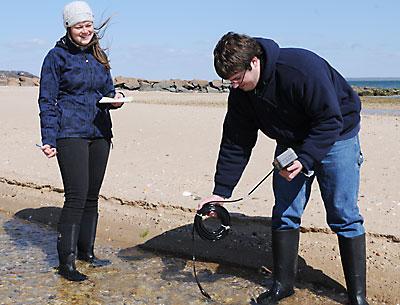A Closer Eye on Shellfishing Waters

During the East Hampton Town Trustees meeting of March 19, Stephanie Forsberg announced that the board would be funding a comprehensive monitoring of trustee waters, both freshwater and marine. The $29,500 project, undertaken in cooperation with Stony Brook University, began yesterday.
Attending the March 19 meeting were a number of baymen who spoke in favor of the nine-member panel’s efforts on their behalf, and on behalf of the inshore waters they depend on for their livelihood.
Trap fishermen, scallopers, and clammers spoke in favor of the trustees’ charging commercial shellfishermen 75 cents each for the bushel bags that bear the trustee emblem, and for charging for boat moorings as well. “The money goes back to you and the harbors,” said Dan Lester.
According to trustee regulations, proof, in the form of a tax return or buyer’s receipt that shows more than $1,000 worth of income from the sale of fish, makes a fisherman eligible for a reduced rate, $50, for a boat mooring. Receipts showing $1,500 or more get you two moorings for $100. A commercial fisherman can obtain a mooring without showing any records for $100 per mooring. Baymen said the fees were fair.
To a man, baymen asked that the trustees not permit the “powering” for clams in any of the town’s water bodies. Powering is the practice of mounting an outboard motor on a frame and using the prop wash to uncover steamer, razor, and hard clams. The method, although efficient, stirs up bottom sediment, which can cover, and kill, juvenile scallops and eelgrass habitat.
“My theory is, why cover up oysters and scallops? Scallops are coming back,” Mr. Lester said.
“I don’t believe in powering. There’s life on the bottom out there,” said Richard King.
Ms. Forsberg suggested passing a resolution outlawing the practice this year, but leaving the possibility of future powering. It was agreed.
The visiting baymen were of a mind when it came to the need for more and better enforcement of existing regulations. In particular, Mr. Lester said the start of this year’s surprisingly good scallop season was “pandemonium,” with wives picking up scallops that their husbands had caught, bagged, and hidden in shallow water so they could dredge for more above the daily limit.
Mr. Lester asked the board to delay the opening of scallop season next fall to allow trap fishermen the opportunity to concentrate on that fishery for a while longer before they switch gears and drag out their dredges.
Jim Lester said it was not only commercial fishermen who overstepped the line. “Kayakers are going into closed areas to get 30 oysters, and they may not even know any better.” He said “every landing in town used to have rules and regulations posted.”
Diane McNally, the trustees’ clerk, and Deborah Klughers, another trustee, said they had pleaded with the town board for more enforcement officers prior to the start of the scallop season, to no avail. “If you could go to the town board and ask them to hire more enforcement,” Ms. McNally said. “We tried.”
“We saw scallop season coming. We knew months ahead. We begged for more enforcement,” Ms. Forsberg added.
The baymen agreed that fines for violating shellfishing regulations needed to be increased, and that the practice by prosecutors of plea-bargaining the fines be stopped. Ms. McNally said a letter could be sent to East Hampton Town Justice Court. Baymen and trustees agreed it would be a good idea to get together with the town’s marine police to discuss the enforcement issue.
Ms. Forsberg earned a doctoral degree in marine biology last year from Stony Brook University, and in the process worked in the laboratory of Dr. Christopher Gobler, a world-renowned expert on algal blooms. “East Hampton hasn’t had the severity of blooms recently like Sag Harbor and Shinnecock,” Ms. Forsberg said. “For instance, we haven’t seen the algae that causes paralytic shellfish poisoning, but the trustees want it to stay that way.”
The trustees have allocated $29,500 for the study. In all, 14 sites will be tested for coliform bacteria associated with sewage. Sixteen sites will be tested for algal blooms. Water samples will be taken weekly from now through the fall and sent to Dr. Gobler’s lab at Stony Brook. In addition, if a bloom does appear, Ms. Forsberg said, “we will amp up the testing so we can look back and understand why. Was it nitrogen, or pollution?”
“This could lead to more areas open for shellfishing. We will follow the D.E.C.’s standards for testing,” she said, adding that Dr. Gobler had the only laboratory around capable of undertaking such comprehensive analysis.
“One thing we want to stress. We’ve raised fees here, raised them there; this is a great example of where the money’s going,” Ms. Forsberg said.
